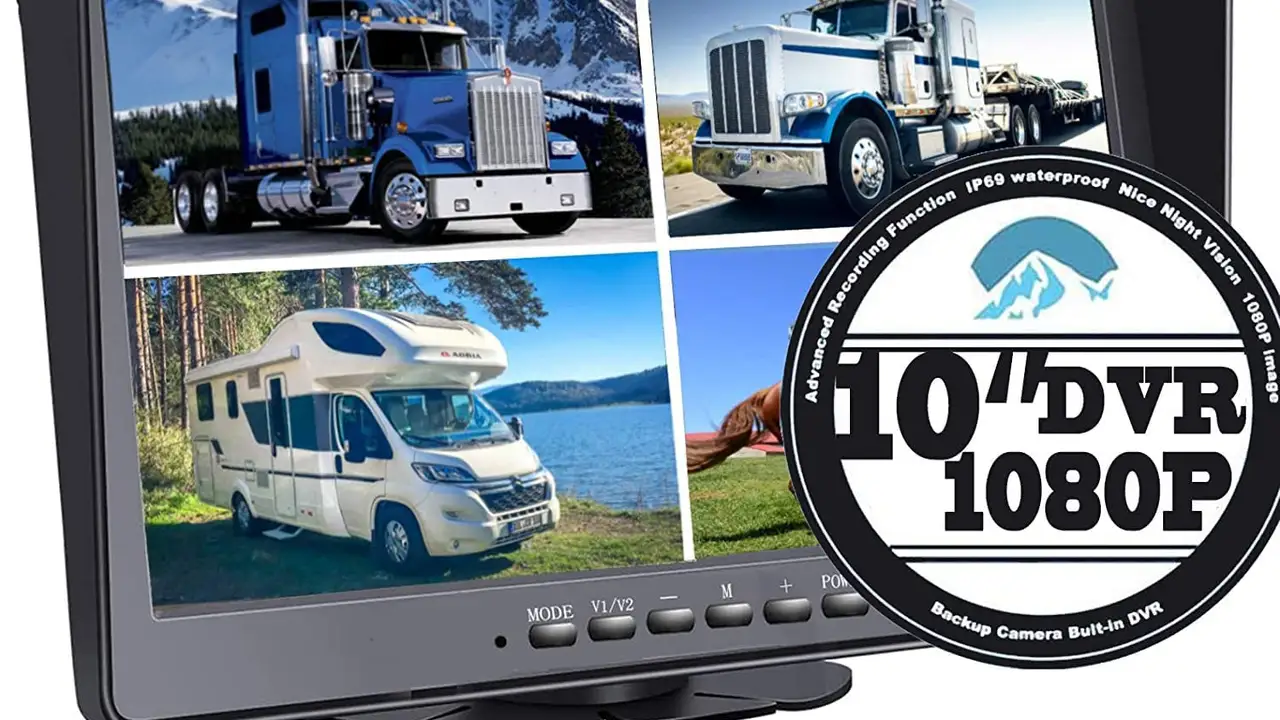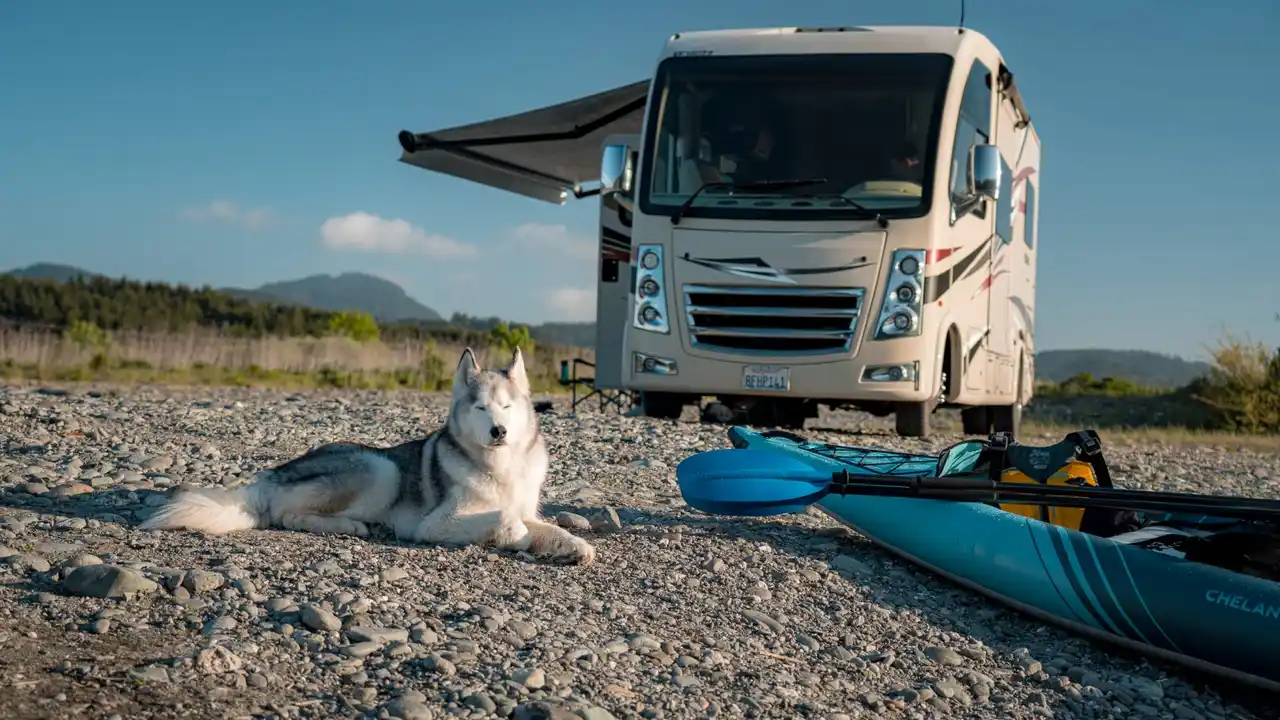RV Backup Cameras: Improving Safety and Visibility

Understanding the Importance of RV Backup Camera Systems
Let's face it, maneuvering a recreational vehicle (RV) can be a daunting task. These behemoths of the road offer incredible freedom and comfort, but their size presents significant challenges, especially when backing up. Blind spots are a major concern, making it difficult to see pedestrians, objects, or even other vehicles behind you. This is where RV backup cameras become invaluable. They act as your extra set of eyes, providing a clear view of what's happening behind your RV, significantly enhancing safety and preventing potentially costly accidents.
Imagine trying to back into a tight campsite with trees, picnic tables, and other RVs nearby. Without a backup camera, you're relying solely on your mirrors and perhaps a spotter. This can be stressful and prone to errors. A backup camera eliminates much of the guesswork, allowing you to see exactly what's behind you and make precise maneuvers with confidence.
Key Benefits of Investing in a High-Quality RV Backup Camera
The advantages of installing an RV backup camera extend far beyond simply avoiding accidents. Here are some of the key benefits:
- Enhanced Safety: This is the primary benefit. Backup cameras drastically reduce blind spots, making it safer to back up in various situations.
- Reduced Stress: Maneuvering a large RV can be stressful, especially in unfamiliar or crowded areas. A backup camera provides peace of mind and reduces anxiety.
- Prevention of Accidents: By providing a clear view of what's behind you, backup cameras help prevent collisions with objects, pedestrians, and other vehicles.
- Improved Maneuverability: Backup cameras allow for more precise and controlled maneuvers, making it easier to navigate tight spaces.
- Time Savings: Avoid unnecessary stops and adjustments by having a clear view of the area behind you.
- Increased Resale Value: A professionally installed backup camera system can increase the resale value of your RV.
- Potential Insurance Discounts: Some insurance companies offer discounts for RVs equipped with backup cameras.
Types of RV Backup Camera Systems Available on the Market
The RV backup camera market is diverse, offering a range of options to suit different needs and budgets. Here's a breakdown of the most common types:
- Wired Backup Cameras: These systems use a physical cable to transmit the video signal from the camera to the monitor. They are generally more reliable and less prone to interference than wireless systems.
- Wireless Backup Cameras: These systems transmit the video signal wirelessly. They are easier to install than wired systems but can be susceptible to interference from other electronic devices.
- Single Camera Systems: These systems consist of a single camera mounted on the rear of the RV. They provide a basic view of what's behind you.
- Multiple Camera Systems: These systems include multiple cameras, often mounted on the sides and rear of the RV. They provide a more comprehensive view of the surroundings.
- Digital Wireless Backup Cameras: These systems use digital technology to transmit the video signal, resulting in a clearer and more stable image than traditional analog wireless systems.
- License Plate Backup Cameras: These cameras are mounted on the license plate and are a discreet option for smaller RVs or trailers.
- Observation Cameras: These cameras are designed to provide a continuous view of the area behind the RV while driving. They can also function as backup cameras.
Factors to Consider When Choosing the Best RV Backup Camera
Selecting the right RV backup camera system requires careful consideration of several factors. Here's what you need to keep in mind:
- Camera Resolution: Higher resolution cameras provide a clearer and more detailed image. Look for cameras with at least 720p resolution, and ideally 1080p for optimal clarity.
- Field of View: The wider the field of view, the more you can see behind your RV. A field of view of at least 120 degrees is recommended.
- Night Vision: If you frequently travel or park in low-light conditions, choose a camera with good night vision capabilities. Infrared (IR) LEDs are commonly used for night vision.
- Water Resistance: RV backup cameras are exposed to the elements, so water resistance is crucial. Look for cameras with an IP67 or IP68 rating.
- Wireless Range: If you're opting for a wireless system, ensure the wireless range is sufficient for the length of your RV.
- Monitor Size and Resolution: Choose a monitor that is large enough and has a high enough resolution to provide a clear and comfortable view.
- Ease of Installation: Consider your DIY skills and choose a system that you can install yourself or hire a professional to install.
- Reliability and Durability: Read reviews and choose a system from a reputable manufacturer known for producing reliable and durable products.
- Price: RV backup camera systems range in price from a few hundred dollars to over a thousand dollars. Set a budget and choose a system that offers the best value for your money.
Recommended RV Backup Camera Products and Detailed Reviews
Based on research and customer reviews, here are some highly recommended RV backup camera systems:
Furrion Vision S 7-Inch Wireless RV Backup System
Description: The Furrion Vision S is a popular wireless backup camera system known for its ease of installation and reliable performance. It features a 7-inch display, a wide-angle camera with infrared night vision, and a stable wireless connection.
Features:
- 7-inch color LCD display
- Wide-angle camera with 120-degree field of view
- Infrared night vision
- Stable wireless connection
- Waterproof camera housing
- Motion detection
- Built-in microphone
Pros:
- Easy to install
- Reliable wireless performance
- Good image quality
- Durable construction
Cons:
- Can be susceptible to interference in areas with high levels of electromagnetic activity
- Relatively expensive
Use Cases: Ideal for RV owners who want a reliable and easy-to-install wireless backup camera system. Suitable for a wide range of RV sizes and types.
Pricing: Approximately $500 - $600.
Haloview MC7108 Wireless RV Backup Camera System
Description: The Haloview MC7108 is another highly regarded wireless backup camera system that offers excellent image quality and a robust wireless connection. It features a 7-inch display, a wide-angle camera with infrared night vision, and a digital wireless signal for minimal interference.
Features:
- 7-inch color LCD display
- Wide-angle camera with 150-degree field of view
- Infrared night vision
- Digital wireless signal
- Waterproof camera housing
- Loop Recording
- Adjustable parking lines
Pros:
- Excellent image quality
- Stable wireless connection
- Wide field of view
- Good night vision performance
Cons:
- Can be slightly more challenging to install than some other wireless systems
- May require additional adapters for certain RV models
Use Cases: Suitable for RV owners who prioritize image quality and a reliable wireless connection. A good choice for larger RVs and those who frequently travel in areas with potential interference.
Pricing: Approximately $400 - $500.
Rear View Safety RVS-770613-HD Digital Wireless Backup Camera System
Description: The Rear View Safety RVS-770613-HD is a digital wireless backup camera system designed for heavy-duty vehicles, including RVs. It features a high-resolution camera, a 7-inch display, and a strong digital wireless signal that can transmit over long distances.
Features:
- 7-inch color LCD display
- High-resolution camera with 130-degree field of view
- Infrared night vision
- Digital wireless signal
- Waterproof camera housing
- Adjustable parking lines
- Split-screen capability (supports up to four cameras)
Pros:
- Excellent image quality
- Strong and stable wireless signal
- Durable and weather-resistant
- Supports multiple cameras
Cons:
- More expensive than some other wireless systems
- Installation may require professional assistance
Use Cases: Ideal for RV owners who need a rugged and reliable backup camera system with a long wireless range and the ability to support multiple cameras. Suitable for larger RVs and commercial vehicles.
Pricing: Approximately $600 - $700.
AMTIFO A7 HD 1080P Wireless Backup Camera
Description: The AMTIFO A7 is a budget-friendly wireless backup camera system that offers surprisingly good performance for its price. It features a 1080P camera, a 5-inch display, and a relatively easy installation process.
Features:
- 5-inch color LCD display
- 1080P camera with 150-degree field of view
- Infrared night vision
- Wireless signal
- Waterproof camera housing
- Adjustable parking lines
Pros:
- Affordable price
- Good image quality for the price
- Easy to install
Cons:
- Wireless range may be limited in some situations
- Build quality is not as robust as more expensive systems
Use Cases: A good option for RV owners on a budget who want a basic backup camera system that is easy to install. Suitable for smaller RVs and trailers.
Pricing: Approximately $200 - $300.
RV Backup Camera Installation Tips and Considerations
Installing an RV backup camera system can be a straightforward process, especially with wireless systems. However, there are a few key things to keep in mind:
- Read the Instructions Carefully: Before you start, thoroughly read the installation instructions provided with your backup camera system.
- Plan the Wiring Route: If you're installing a wired system, plan the wiring route carefully to avoid sharp bends or areas where the cable could be damaged.
- Secure the Camera Mount: Ensure the camera mount is securely attached to the RV. Use appropriate screws or bolts and consider using sealant to prevent water intrusion.
- Connect the Power Correctly: Connect the power wires to a reliable power source. You can tap into the RV's taillight wiring or use a dedicated power source.
- Test the System: After installation, test the system thoroughly to ensure it is working properly. Check the image quality, wireless range, and night vision capabilities.
- Consider Professional Installation: If you're not comfortable installing the system yourself, consider hiring a professional installer.
Troubleshooting Common RV Backup Camera Issues
Even with the best backup camera systems, occasional issues can arise. Here are some common problems and how to troubleshoot them:
- No Image on the Monitor: Check the power connections to both the camera and the monitor. Ensure the camera is turned on and that the monitor is set to the correct input.
- Poor Image Quality: Clean the camera lens. Check the wireless signal strength. Ensure the camera is properly focused.
- Interference: Try repositioning the camera or monitor. Use a digital wireless system to minimize interference.
- Wireless Connection Issues: Ensure the camera and monitor are within range of each other. Check for obstructions that could be blocking the wireless signal.
- Night Vision Problems: Ensure the night vision feature is enabled. Check the camera lens for dirt or debris.
RV Backup Cameras and Legal Requirements
It's important to be aware of any legal requirements regarding backup cameras in your area. While backup cameras are generally not mandatory, some states may have specific regulations regarding their use. Check with your local Department of Motor Vehicles (DMV) for more information.
The Future of RV Backup Camera Technology and Innovation
The RV backup camera market is constantly evolving, with new technologies and innovations emerging all the time. Here are some trends to watch for:
- Higher Resolution Cameras: Expect to see more RV backup cameras with 4K resolution, providing even clearer and more detailed images.
- Advanced Driver-Assistance Systems (ADAS): Backup cameras are becoming integrated with ADAS features such as lane departure warning, blind spot monitoring, and automatic emergency braking.
- Artificial Intelligence (AI): AI is being used to enhance backup camera systems with features such as object detection, pedestrian recognition, and automatic parking assistance.
- 360-Degree Camera Systems: These systems provide a complete view of the RV's surroundings, eliminating blind spots and making maneuvering even easier.
- Wireless Connectivity Improvements: Expect to see more reliable and secure wireless connections with longer ranges and less interference.
Maintaining Your RV Backup Camera for Longevity
To ensure your RV backup camera system continues to function properly for years to come, proper maintenance is essential. Here are some tips:
- Clean the Camera Lens Regularly: Use a soft, lint-free cloth to clean the camera lens. Avoid using harsh chemicals or abrasive cleaners.
- Protect the Camera from the Elements: When not in use, consider covering the camera with a protective cover to shield it from rain, snow, and sun.
- Inspect the Wiring: Periodically inspect the wiring for any signs of damage or wear. Replace any damaged wires immediately.
- Check the Connections: Ensure all connections are secure and free from corrosion.
- Update the Software: If your backup camera system has software updates, install them regularly to ensure optimal performance.
RV Backup Camera Use Cases Beyond Backing Up
While primarily designed for backing up, RV backup cameras can be useful in a variety of other situations:
- Monitoring Tow Vehicles: If you're towing a car or trailer behind your RV, a backup camera can help you monitor the towed vehicle and ensure it's tracking properly.
- Security Surveillance: A backup camera can be used as a security surveillance system to monitor your campsite or parking area.
- Navigating Tight Spaces: Backup cameras can be helpful when navigating narrow roads or parking in tight spaces.
- Observing Wildlife: If you're traveling in areas with wildlife, a backup camera can help you spot animals that may be behind your RV.
Comparing RV Backup Cameras to Other Safety Technologies
While RV backup cameras are a valuable safety tool, it's important to consider them in conjunction with other safety technologies, such as:
- Mirrors: Properly adjusted mirrors are essential for safe driving.
- Blind Spot Monitoring Systems: These systems alert you when there is a vehicle in your blind spot.
- Tire Pressure Monitoring Systems (TPMS): TPMS can help you detect low tire pressure, which can lead to accidents.
- Dash Cams: Dash cams record video footage of your travels, which can be helpful in the event of an accident.
Choosing Between Wired and Wireless RV Backup Cameras A Detailed Comparison
The decision between wired and wireless RV backup cameras often boils down to a trade-off between convenience and reliability. Let's delve deeper into the pros and cons of each type:
Wired RV Backup Cameras
Pros:
- Greater Reliability: Wired connections are generally more stable and less susceptible to interference than wireless connections. This means a more consistent and reliable video feed.
- Less Susceptible to Interference: Wired systems are not affected by wireless signals from other devices, such as cell phones or Wi-Fi routers.
- Higher Image Quality Potential: Wired connections can often transmit higher resolution video signals without compression, resulting in a sharper and more detailed image.
- Security: Wired connections are inherently more secure than wireless connections, as they cannot be intercepted by unauthorized users.
Cons:
- More Complex Installation: Installing a wired system requires running a physical cable from the camera to the monitor, which can be time-consuming and challenging.
- Potential for Cable Damage: The cable can be damaged by abrasion, heat, or other environmental factors.
- Less Flexible: Wired systems are less flexible than wireless systems, as the camera and monitor must be physically connected.
Wireless RV Backup Cameras
Pros:
- Easier Installation: Wireless systems are much easier to install than wired systems, as they do not require running a physical cable.
- More Flexible: Wireless systems are more flexible than wired systems, as the camera and monitor can be placed anywhere within the wireless range.
- Convenient: Wireless systems are more convenient than wired systems, as they eliminate the need for a physical cable.
Cons:
- Susceptible to Interference: Wireless systems can be affected by wireless signals from other devices, such as cell phones or Wi-Fi routers.
- Less Reliable: Wireless connections are generally less stable and reliable than wired connections.
- Lower Image Quality Potential: Wireless connections may compress the video signal, resulting in a lower quality image.
- Security Concerns: Wireless connections are potentially vulnerable to interception by unauthorized users.
Which is Right for You?
If reliability and image quality are your top priorities, and you're comfortable with a more complex installation, a wired system is the better choice. If ease of installation and convenience are more important, and you're willing to accept the potential for interference and lower image quality, a wireless system may be a better fit.
Understanding IP Ratings and Water Resistance for RV Backup Cameras
The Ingress Protection (IP) rating is an international standard that defines the level of protection provided by an enclosure against solid objects and liquids. For RV backup cameras, the IP rating is a crucial indicator of its ability to withstand the elements. The IP rating consists of two digits: the first digit indicates protection against solid objects (dust, dirt, etc.), and the second digit indicates protection against liquids (water, rain, etc.).
Here's a breakdown of common IP ratings for RV backup cameras:
- IP67: Protected against dust and temporary immersion in water. This means the camera can be submerged in water up to 1 meter deep for up to 30 minutes without damage.
- IP68: Protected against dust and continuous immersion in water. This means the camera can be submerged in water deeper than 1 meter for an extended period of time without damage. The exact depth and duration are typically specified by the manufacturer.
- IP69K: Protected against dust and high-pressure, high-temperature water jets. This is the highest level of protection and indicates that the camera can withstand harsh cleaning conditions.
For RV backup cameras, an IP rating of IP67 or IP68 is generally recommended. If you frequently travel in areas with heavy rain or snow, or if you plan to wash your RV frequently, an IP68 or IP69K rating is preferable.
The Role of Infrared (IR) LEDs in RV Backup Camera Night Vision
Night vision is a crucial feature for RV backup cameras, especially if you frequently travel or park in low-light conditions. Infrared (IR) LEDs are commonly used to provide night vision capabilities. IR LEDs emit infrared light, which is invisible to the human eye but can be detected by the camera's sensor. This allows the camera to capture images in complete darkness.
The effectiveness of IR night vision depends on several factors, including:
- Number of IR LEDs: The more IR LEDs, the brighter the night vision image.
- IR LED Wavelength: Different IR LED wavelengths have different ranges and levels of visibility.
- Camera Sensitivity: The sensitivity of the camera's sensor to IR light affects the quality of the night vision image.
When choosing an RV backup camera with night vision, look for a system with a sufficient number of IR LEDs and a sensitive camera sensor. Read reviews to get an idea of the night vision performance in real-world conditions.
Understanding Camera Lens Angles and Their Impact on Field of View
The lens angle of an RV backup camera determines its field of view (FOV), which is the extent of the area that the camera can capture. A wider lens angle provides a wider FOV, allowing you to see more of the surroundings behind your RV. However, a wider lens angle can also introduce distortion, especially at the edges of the image.
Common lens angles for RV backup cameras range from 120 degrees to 170 degrees. A 120-degree lens angle provides a good balance between FOV and distortion. A 170-degree lens angle provides the widest possible FOV, but the image may be more distorted.
When choosing an RV backup camera, consider the lens angle and how it will affect your viewing experience. If you prioritize a wide FOV, a 170-degree lens angle may be a good choice. If you prefer a less distorted image, a 120-degree or 130-degree lens angle may be a better option.
The Impact of Monitor Size and Resolution on User Experience
The size and resolution of the monitor are important factors to consider when choosing an RV backup camera system. A larger monitor provides a more comfortable viewing experience, especially for those with vision problems. A higher resolution monitor provides a sharper and more detailed image.
Common monitor sizes for RV backup camera systems range from 5 inches to 9 inches. A 7-inch monitor is generally considered a good compromise between size and portability. Monitor resolution is typically measured in pixels (e.g., 800x480, 1024x600). A higher pixel count results in a sharper image.
When choosing an RV backup camera system, select a monitor size and resolution that meets your individual needs and preferences. Consider your vision and the size of your RV when making your decision.
:max_bytes(150000):strip_icc()/277019-baked-pork-chops-with-cream-of-mushroom-soup-DDMFS-beauty-4x3-BG-7505-5762b731cf30447d9cbbbbbf387beafa.jpg)





